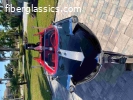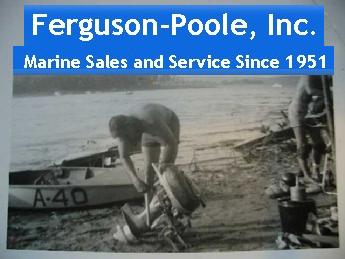Gel coat Repair
Maybe you still don't know if you should restore your existing finish or simply bite the bullet and have it painted. Maybe the gelcoat is entirely salvageable but there was a big fiberglass repair made. Maybe your boat, like most, is showing its age with fine patina of scars, nicks, and gouges. Regardless, repairing the finish you have will always be easier than refinishing.
Repairing gelcoat is as easy as filling a hole, sanding it flush, and polishing it. The hard part about repairing gelcoat is color matching. Men are seven time more likely to be color blind than women. Men are also seven times more likely to own a boat than women. This can be interpreted two ways: First, you've got a pretty good shot that no one's going to notice you screwed up on the color matching. Second, you're pretty damned likely to screw up on the color matching.
The first step to repairing gel coat is polishing your boat. Polishing your boat will reveal the true color of the gel coat. Without this step, any color you mix up will be wrong.
Newer boats have color codes in their Hull Identification Numbers (HIN). When hired to repair damaged gelcoat on these boats, my first step is to call Spectrum Color (a gel coat company in Tacoma), and give them make, model, and HIN. Invariably, the gelcoat is available, prepackaged, and color matched. These guys make life a lot easier for me.
When dealing with fifty year old boats, it becomes a little trickier. If you can bring yourself vandalize your boat and remove a chip of the polished gel coat (about the size of a quarter), you can send the chip to Spectrum Color, (they are local for me. You may find another company more convenient to your location), and they will analyze and match it. If the color is a match for one that's already in their database, it will be available in quarts. If it is a new color that requires mixing up a fresh batch from scratch, there is a one gallon minimum.
If you can't or don't want to have it factory matched, it's up to you to mix up the right color.
Side note: When mixing up colors, use small amount during the experimentation phase and use amounts that are easily converted to larger amounts. Use one or two ounces of base and add tints in numbers of drops, then write down your formula and multiply those numbers to get the amount of finished gelcoat you need for the entire repair.
No two batches, regardless of how careful you are, will be exactly the same color. Mix up more than you need in advance and you won't have to worry about matching your match. Left over gelcoat can be kept for future repairs.
This probably goes without saying, but just in case: Always tint your gelcoat before catalyzing.
The first thing you'll need is the right base. As mentioned in other portions of this book, laminating gel coat is air inhibited which means your repair won't fully cure if it's exposed to air. For repairs to an existing gel coat surface, you will need either a finishing gel coat, which has air inhibitors added to it, (The air inhibitor floats to the surface after it's been catalyzed and allows the gel coat to fully cure), or you will need laminating gel coat and a bottle of PVA (a brushable mold release agent that creates an air-tight seal as it dries). The finishing gel coat is easier because it's a self-contained product.
For smaller nicks and gouges, you want “Gel-paste”. The paste has better filling qualities than the more liquid gel coat and it will adhere to hull sides without sagging. For large repairs, I recommend “Gel-coat”, it is sprayable which makes it easier to cover large areas evenly.
For shades of white, get the white gel coat (or paste) and the tints you think you will use to get the right shade. For colored gelcoat, get the clear and add the color to it. (If you're trying to make red and you buy the white gel coat as a base, you will end up with pink, no matter how much red you add to the mix).
Small Repairs and Scratches
The prep for small repairs to gel coat is identical to small repairs to fiberglass (see part one of this book). First, create a smooth tapered surface for the repair to adhere to. If the repair is a chipped or gouged area, take some toothy sandpaper and knock down all the rough edges until you have a smooth bowl-shape. If the damage penetrates the gelcoat and goes into the fiberglass, you'll need to repair the fiberglass first.
If the damage is in the form of a deep scratch, take a screwdriver or a sharp metal scraper and notch out a vee-shape along the length of the scratch. This taper will allow the new gelcoat to mechanically bond to the old gelcoat.
Clean the area thoroughly with denatured alcohol or acetone, then tape around the repair as close as possible. The tape not only protects the surrounding area from drips and sags, but also acts as a sacrificial barrier in the sanding stage.
With the area cleaned and taped off, catalyze enough gel-paste to fill the repair. Using a plastic spreader or a flexible putty knife, fill the damaged area by pressing it into the void not dragging it across the damage. Do this as evenly and smoothly as possible. The goal is to minimize sanding.
Like all polyester resins, gelcoat will shrink as it cures. Pressing the gelcoat into the repair should cause the gelcoat to rise behind the spreader as you're moving it across the repair. This will take care of the shrinkage.
If you're using a finishing gel coat, you're done for the moment. If you're using a laminating gel coat, you'll need to seal off the repair for it to fully cure. This can be done by lightly pressing acetate or another clear sheet of plastic onto the repair, or you can use PVA. I prefer PVA because it doesn't require touching the gelcoat after you've applied it. Take a Pre-Val sprayer (Available at most hardware stores), and mist over the repair with a light coat of PVA. Give it a half an hour to dry, then spray on another full wet coat.
The PVA is water soluble so it cleans off with a garden hose. Needless to say, don't try using it on a rainy day.
Regardless of the type of gelcoat used (finishing or laminating), you should now disappear for a day. The gelcoat will be sandable in a few hours, but allowing extra time to fully cure will prevent having to reapply it to repairs that continue to shrink.
Large Repairs
Side note: If you are repairing a large area, any variation on color match will be very noticeable. For large repairs, I highly recommend having it professionally color-matched.
For large repairs, it is hard to apply gel coat evenly with a spreader. To repair a large area, or panel, it should be sprayed. I use Pre-Val sprayers because they are disposable, self-contained units that don't require excessive clean up time. You can use a spray gun to shoot gel coat, just make sure the tip size is big enough to handle the viscosity of gelcoat. Thinning is done with acetone for either method.
The prep for a large area is the same as the prep for painting a boat. The surface needs to be perfectly fair prior to a gelcoat application. If it isn't, the danger of sanding through the gelcoat when trying to buff it in is too great. See the “Painting a Boat” section for a complete description of the fairing process. The goal is to fair the repair area a little bit shallower than the surrounding area. You want the thickness of the finished gelcoat repair to be flush with the rest of the boat, not sitting on top of it.
Side note: Gel coat is polyester based and will not adhere well to epoxy. Fairing compound for use prior to gelcoat should be either polyester or vinylester based. Not epoxy!
Mask off the surrounding areas for over-spray protection and clean the surface as described earlier.
Because you will be applying multiple coats, you will need laminating gel coat, not finishing gel coat. Trying to apply a full thickness in one coat is going to make your repair a sloppy mess and triple the amount of time you spend sanding and polishing.
When your prep work is done and the surface is ready, Catalyze the gel coat, but only catalyze as much as you'll use in a single coat.
Using proper spray techniques, mist the repair area with gelcoat and allow half an hour for the gelcoat to kick. Then catalyze the next coat and spray on a full wet coat. For a finished thickness of 20-30 mils, you will probably need three or four full coats. Allow the gelcoat time to kick before adding subsequent coats.
You want the finished spray application to be thicker than the surrounding gelcoat. This will give you material to work with when you're sanding and polishing.
When the gelcoat has been applied, finish with an application of PVA as described earlier. Use two full wet coats to ensure complete coverage.
Sanding and Polishing
Finishing a gelcoat repair is similar to the Polishing Gel Coat section except the are extra steps at the beginning.
The first step is to fair the repaired area. For large repairs and well applied small repairs, use 320 grit sandpaper and take care not to sand into the adjacent factory gel coat any more than is necessary to feather the edge.
For sloppy small repairs, get a head start with 220 before moving on to the 320.
The next step is to remove the masking tape around the repair. You want the subsequent sanding to blend into the old gel coat.
Start with 600 grit wetordry and wet sand the repair. For this step, you want to cover an area the is a few inches bigger than the repair all around. Next, move on to 800 grit and widen the area a few more inches. Then 1000 grit and an even bigger area.
Make sure you clean off the repair area before changing grits and visually make sure you've removed all of the previous sanding scratches.
Finish with rubbing and polishing compounds as described in the Polishing Gel Coat section. Seal the entire area and wax.
If your color match was close, but not perfect, small repairs will be nearly invisible.












